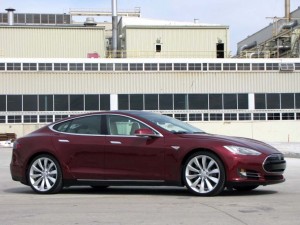Silicon Valley venture capitalist Steve Jurvetson got an unexpected surprise this week when he was handed the keys to a new Tesla Model S – more than two weeks before the California electric vehicle maker had officially planned to begin retail deliveries of the new battery-powered sedan.
Tesla investor Jurvetson is tooling around in a maroon Model-S with the California license plate “TSLA S1.” While other buyers will have to wait until June 22, the battery-car start-up is hoping to have thousands of the new sedans on the road before year-end, with a second product, the Model-X crossover, set for launch in 2013.
But will the market live up to expectations? There are plenty of reasons to be skeptical, though demand for plug-in hybrids, such as the Chevrolet Volt, and battery-electric vehicles, like the Nissan Leaf, are slowly gaining momentum.
“There are now approximately 30,000 plug-in vehicles on U.S. roads, four or five times as many as there were a year ago,” writes Tesla founder Elon Musk in his personal blog, adding that “We firmly expect that the electric-car sales rate will continues (to) rise, though it will be slow.”
In fact, the number of available products could grow faster than the overall market, some observers warn.
Along with the Tesla Model S new battery-based vehicles coming to market in the near future include:
- Ford is now beginning serious deliveries of the new Focus Electric model, with the maker also planning to launch a plug-in version of its new Fusion sedan and C-Max “people-mover” in the months ahead;
- Toyota recently rolled out the Prius Plug-in and will follow this year with a battery-electric version of the RAV4 crossover – which will use a driveline developed by Tesla;
- Fiat is readying a battery-electric version of its little 500 model;
- Honda will begin selling the Fit EV battery electric vehicle in California and Oregon this summer, with sales expanding to the East Coast in 2013.
(The EPA rates the new Honda Fit EV at an all-time high 118 MPGe. Click Here for that story.)
Skeptics dub models like the Fiat 500 EV and Honda Fit EV “compliance cars,” primarily intended to meet new zero-emissions regulations rather than to actually create a serious electric vehicle market. Sergio Marchionne, CEO of both Fiat and U.S. partner Chrysler, all but acknowledged that in recent days, adding that the maker expects to lose thousands of dollars for every 500 EV it sells.
But other industry leaders, including actively green-minded Ford Chairman Bill Ford, insist they take the potential battery-car market seriously and intend to nurture the segment as demand builds.
May sales numbers suggest that even as buyers back away from other high-mileage vehicles – now that gasoline prices are dropping – demand for battery-based vehicles continues to grow…slowly.
The top-seller last month was the Chevrolet Volt, posting sales of 1,680 vehicles. While that’s up from just 481 in May 2011 it’s still significantly short of the pace the maker was aiming for, General Motors officials stating a goal of producing 45,000 Volts for the U.S. market this year.
The number two spot was grabbed by the Prius Plug-in, at 1,086 units. That was, however, barely 5% of the total conventional Prius liftbacks sold in May, and not even a third of the new Prius C and Prius V hybrids.
What continues to puzzle analysts is the sharp downturn in demand for the Nissan Leaf, sales slumping to just 510 in May, off from 1,142 a year before. Leaf volumes have been sliding for much of the year, a problem the maker contends is the result of diverting production to other new markets around the world. Perhaps the real test will come late in 2012 when Nissan launches production of its battery-car on a new line in Smyrna, Tennessee.
Sales of all other battery-based vehicles, including the first Focus Electrics, the Fisker Karma and Mitsubishi’s i-MiEV, added up to only a few 100.
Fisker, in particular, has been struggling to build demand in the wake of a series of setbacks – including a recall caused by a manufacturing defect at its battery suppliers, and a Texas fire some have blamed on the car, but which Fisker insists was not its fault.
For its part, Tesla hopes to ramp up interest in battery car technology when the first official production vehicle rolls off the line at its new factory in Fremont, California, barely two weeks from now. Among other things, it has set up an online countdown clock ticking away the days, hours and minutes.
But skeptics might argue that the real clock would measure how long it might take to build demand for battery technology to a sustainable level.

